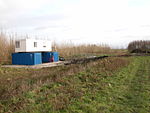Bad Nieuweschans railway station

Bad Nieuweschans (Dutch pronunciation: [bɑt ˌniuʋəˈsxɑns]; abbreviation: Nsch), previously named Nieuweschans (1868–2013), is an unstaffed railway station in the village of Bad Nieuweschans, Netherlands. It connects the Harlingen–Nieuweschans and Ihrhove–Nieuweschans railways and is situated between Winschoten, Netherlands and Weener, Germany. The station building was completed in 1867 and demolished in 1973. Train services started on 1 November 1868. Trains were operated by Staatsspoorwegen (1868–1937), Nederlandse Spoorwegen (1938–2000), NoordNed (2000–2005), and Arriva (2006–present). The station has two tracks and two platforms. There are two local train services with trains every hour to and from Groningen and Leer (Germany). There are also two bus connections at the station provided by Qbuzz.
Excerpt from the Wikipedia article Bad Nieuweschans railway station (License: CC BY-SA 3.0, Authors, Images).Bad Nieuweschans railway station
Stationsstraat, Oldambt
Geographical coordinates (GPS) Address Nearby Places Show on map
Geographical coordinates (GPS)
| Latitude | Longitude |
|---|---|
| N 53.184166666667 ° | E 7.1994444444444 ° |
Address
Stationsstraat
9693 AA Oldambt
Groningen, Netherlands
Open on Google Maps









